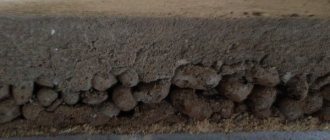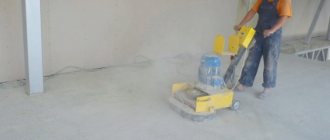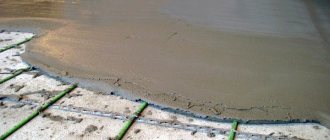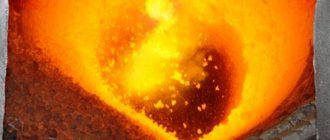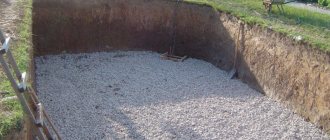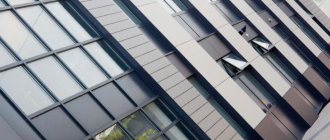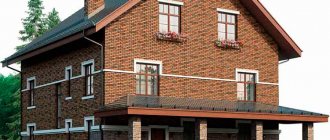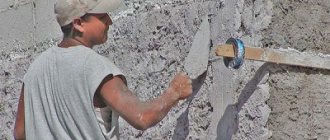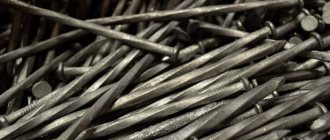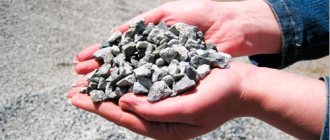We are absolutely sure that anyone over 10 years old knows the mysterious word “expanded clay.” Many people believe that this is some kind of building material, or drainage felt, or plant food, or something else...
But few will answer a simple question: what is expanded clay? It will be difficult, and please describe the properties of this material. The range of applications is so wide that listing them would take a lot of time. It remains a big mystery where expanded clay is mined or maybe it is produced? And if they are made, then from what?
Increasingly, when reviewing heat-insulating materials that have literally flooded our construction markets, the keywords for description are: new, modern, innovative, and so on. Indeed, the quantity, variety, and most importantly the high quality of numerous materials has recently become more and more surprising and pleasing.
Today we will talk about material that is well known from childhood. Let us, so to speak, eliminate the gaps in knowledge. Indeed, expanded clay is primarily a building material, which often finds its use outside the construction site. People who are very far from construction sites sometimes encounter expanded clay balls.
Expanded clay properties application
You don’t have to look far for an example; many have seen pots on windowsills with indoor plants, at the bottom of which small brown balls were placed. So these peas are the mysterious material that we are talking about. And at the bottom of the pot, expanded clay served only the role of excellent drainage for your favorite flowers.
Expanded clay is a lightweight material with a large degree of pores that is widely used in construction. Produced by firing clay. Clay shale is often used for the same purposes. The resulting expanded clay gravel takes on an oval, heterogeneous shape. There is also a concept: expanded clay crushed stone - the only difference between the material is its geometry, the “balls” are more like cubes with sharp edges and uneven corners.
It is not uncommon that the material can be found in the form of expanded clay sand, in which case the balls are very small, they are obtained by crushing, they are less porous and harder. Sand granules often become a constituent material in cement mortars used in construction. Expanded clay is distinguished into three fractions: 5-10 mm, 10-20 mm, 20-40 mm.
Expanded clay is produced from clay rocks containing about 30% quartz and ferrous impurities about 10%, as well as organic inclusions. That is why the material is essentially natural and natural, but it is prepared using an artificial method.
Depending on how the clay or shale was fired, expanded clay is obtained with a range of volumetric mass - from 350 to 600 kg/m³ and higher when it comes to expanded clay sand.
Expanded clay density and material grade
Expanded clay is lightweight, and the density of the material determines its quality and area of use. It is this value that affects its quantity per cubic meter and, consequently, the weight of the expanded clay bag. This indicator depends on the fraction: the larger the granules, the lower the density of the material.
Helpful advice! When purchasing expanded clay, you must take into account the bulk density, which indicates the grade of the material.
The quality of expanded clay is determined by its bulk density index and manufacturing method
Production technology affects the density of the material. There are four ways to obtain this material:
- Dry. The simplest technology applied to homogeneous types of clay without impurities. Humidity does not exceed 9%.
- Wet.
- Plastic. The most common method. Granules are formed from wet clay and sent to the oven. The humidity of the raw materials reaches 30%.
- Powder-plastic. It is similar to the previous method, but the basis is dry clay, which is crushed, and then moistened and subjected to temperature influences.
It is the bulk density that is the brand of expanded clay. It is designated by the letter M with the corresponding number. For example, M300 means that 1 cube of expanded clay weighs from 251 to 300 kg. The lower the grade, the higher the thermal insulation properties. This material is best suited for insulating ceilings and floors.
In construction, expanded clay is most often used to insulate floors, walls and ceilings.
Expanded clay of a lower grade (fractions 20-40) is used as a heat insulator in foundations and basements. It is widely used for landscape design. Material with a minimum density is used to insulate walls, communications and facades. The finest expanded clay (with a fraction of up to 10 mm) is used in the preparation of expanded clay concrete for pouring floors.
How is expanded clay made?
The parent of expanded clay, as we have already noticed, is a special clay rock. The essence of the process is based on the well-known property of clay - to swell when heated. Special pyrogenic ovens, similar to drums, which rotate in a circle at a certain angle, are used in the preparation of expanded clay.
Raw granules are fired to obtain a certain structure. Clay balls at an angle rush towards the burning torch.
Having received a heat shock of about 1200 degrees, the clay composition boils and swells. On the outside, the material melts and turns brown. Then comes one of the most important steps: cooling. The process consists of several stages. Surely builders know that there is such a term as “soil swelling coefficient”; it is this principle that is incorporated into the magical process of transforming clay mass into expanded clay. The firing itself lasts about 45 minutes.
Expanded clay technical characteristics
The classification of the material is determined by its bulk density, measured in kilograms per cubic meter, ranging from 250 kg to 1000 kg. This indicator is also called volumetric weight and is characterized as the ratio of volume to mass of the material. Expanded clay grades accordingly start with the value M 250 and end with the name M 1000.
Since the oven rotates, the granules take on an almost round shape with a diameter ranging from 0.2-0.4 cm. To make it easier to decide on the brand, it is enough to know the required size:
- fractions of 5-10 mm correspond to a grade of 450-400 kg/m3;
- fractions of 10-20 mm correspond to a grade of 400-350 kg/m3;
- fractions of 20-40 mm correspond to a grade of 350-250 kg/m3.
GOST regulates grades from 250 to M 600. Technical conditions everywhere allow the production of materials with values of M 800 and M 1000. In order not to get completely confused, you should remember a simple rule: lower grade - higher quality.
Expanded clay is one of the top ten organic thermal insulation materials that are constantly in demand in the construction market. The thermal conductivity coefficient strongly depends on the fractions and lies in the range of 0.06-0.17 W/m. The coefficient is characterized by a linear relationship: we reduce the size of the material - we increase the thermal insulation qualities.
Comparative table of thermal conductivity of materials
If the numbers do not provide a clear and understandable understanding of thermal conductivity, then we hope the figure below gives a clearer picture:
Let us add that expanded clay is also characterized by strength. The value varies from P15 to P400. If the number in the value is large, then this indicates better quality. Increased density gives the material correspondingly higher strength. Builders distinguish expanded clay into the following grades:
Expanded clay gravel
- The form is most in demand in the construction industry.
- The grains are spherical, sometimes oblong, irregularly oval in shape; after swelling of the clay they acquire a red-brown color.
- Grains are divided according to the size of the fractions into three groups: 5–10, 10–20 and 20–40 mm;
- It is often included in fillers of various brands of concrete, as it has high strength.
- The thermal conductivity coefficient is the lowest of all types of material. Gravel 10-20 mm grade by bulk density M350 coefficient value is not more than 0.14 W/m.
Expanded clay crushed stone
- Essentially it is crushed expanded clay mass. Large, oversized grains and granules are sent to the crusher, the resulting material is characterized by sharp, uneven edges
- The application does not go beyond filler into concrete mixtures. Crushed stone fraction – 5–40 mm.
Expanded clay sand
- In construction, it is most often used as insulation, with a fine fraction of up to 5 millimeters.
What is expanded clay?
This is one of the most common construction products today. It has excellent quality and performance parameters. The price is accessible to a wide range of consumers.
Expanded clay is a lightweight, cheap building material obtained by firing clay and slate. It consists of one hundred percent natural ingredients and is completely safe for human health. The unique production technology allows us to produce balls of different bulk densities. There are about ten brands (from 250 to 800).
Pros and cons of expanded clay
Expanded clay, a porous substance with low weight, is lighter than mineral wool and other foamed polymers, but it is durable. Its weight suggests insulation of the ceilings, since there is no significant load on the ceiling.
At the same time, insulating floors followed by cement screed makes the process easier, since during work you can walk on the material without fear for its integrity. The main advantages of expanded clay lie in the following:
- high level of noise and heat insulation. The porous structure resists the propagation of sound waves, and as insulation, the granules work like a thermos;
- low volumetric weight;
- environmental friendliness;
- high resistance to mechanical stress, no rodents are afraid of it;
- expanded clay is completely safe for humans, no larvae grow in it;
- fire-resistant material that does not ignite;
- resistance to negative temperatures, frost resistance of at least 25 cycles;
- has durability, is not prone to rotting, does not form mold or fungi;
- neutral to chemicals;
- simple installation, can be done by one person without construction skills;
- low cost;
- does not decompose over time;
- widely used in growing domestic plants. Expanded clay prevents moisture evaporation, providing control of water balance;
- a popular substrate among gardeners.
With all its advantages, it is worth noting that expanded clay has some disadvantages:
- absorbs water easily, but dries poorly. Because the melted, brown crust is a ceramic coating that prevents drying. Perhaps this is not bad for hydroponics, but it is unacceptable for material - insulation;
- as insulation, it is recommended to fill in expanded clay, without further cement screed;
- good thermal insulation requires a lot of material; the backfill layer must be at least 500 mm.
Disadvantages - individual parameters
The advantages of expanded clay (good strength, low thermal conductivity) are practically not affected by its individual disadvantages. Unlike numerous heat insulators, the disadvantages of expanded clay are very limited.
These include the following:
- increased tendency to dust formation, which is especially noticeable when working indoors. A respirator, which should always be at hand at a construction site, helps solve the problem;
- long-term drying of wet material - how hard expanded clay absorbs moisture, so difficult it is to get rid of it later. To prevent high humidity in rooms containing expanded clay, reliable moisture and vapor protection should be provided in advance.
Minor shortcomings, combined with high performance indicators, allow us to rate the practicality of expanded clay at 4 points.
The main properties and characteristics of expanded clay gravel, as well as its pros and cons, largely depend on the production technology and the correctness of the stages of its implementation.
Scope of expanded clay
Due to its low cost and attractive properties, expanded clay is a very popular construction and heat-insulating filler. The material does not require specific skills to work with, it is lightweight, inexpensive, and accessible, which is why its scope of application is unusually wide and varied:
- production of facing and high-hollow ceramic bricks;
- production of expanded clay concrete blocks,
- insulation of floors, walls, attic floors, resulting in a reduction in heat loss by 70%;
- use as a porous aggregate in the production of lightweight concrete.
- everywhere in the construction complex: residential buildings, industrial buildings, country houses and much more, where this inexpensive material is in demand.
- as design solutions in the local area - various paving slabs, bulk structures;
- in agriculture, the water balance indicator stabilizes after the inclusion of expanded clay grains in the soil;
- in wastewater treatment plants, participates in rough cleaning using filters;
Houses built from expanded clay blocks back in the days of the Soviet Union still safely accommodate thousands of families throughout Russia and beyond for more than half a century. In addition to the fact that they have good strength and retain heat well, our climate is also conducive to the use of this frost-resistant and not capricious building material.
Many people remember these structures as “people's construction projects”. In general, it is worth noting that concrete or blocks made with the addition of expanded clay have high strength characteristics and remain light despite their large dimensions.
Main characteristics of expanded clay
Expanded clay is highly resistant to chemical influences, high and low temperatures. The practice of using expanded clay shows that it is resistant to fungal attack, mold, rot and environmental changes, even over many years of use. Expanded clay is gifted with high sound insulation and low moisture absorption properties.
All of the above properties of expanded clay find their application in such areas of construction as:
- block production;
- filling the floor and walls;
- insulation of the foundation and roof;
- thermal insulation of pipes.
Expanded clay is also widely used in road construction in the construction of bridges and overpasses for drainage and filtration of wastewater. Expanded clay is actively used for landscape design. In this case, it acts as a decorative material, aquarium keeping, flower breeding and well masonry.
The use of expanded clay for floor insulation
The sequence of insulation of all types of floors has the same algorithm.
- free the surface from the old coating;
- Seal cracks and cracks with mortar;
- Flooring can be installed directly on an earthen base. First compact the earth, make a cushion of sand and pour gravel.
- Expanded clay must be insulated from moisture with a layer of waterproofing, using, for example, Izospan D.
- pour expanded clay onto the isospan film. Advice from experienced builders says that insulation requires a good layer. It is advisable to form a layer of at least 10 cm.
- Next we lay out the reinforced mesh
- We perform the screed with cement mortar.
- We lay out a vapor barrier - isospan C, then lay a new floor.
If you are insulating the ceiling, then it is better to use expanded clay of two fractions as part of the “pillow”. This technique will allow you to create a denser backfill, which more effectively retains heat in the living space.
In the recent past, it was problematic to buy expanded clay for private use, since it was sold in bulk and in large volumes. It was extremely inconvenient to buy an expanded clay machine, with little need.
Nowadays, everything is much simpler and manufacturers pack their goods in bags of different volumes. You can buy expanded clay in packaging in the required quantity without overpaying for extra supplies. The packaging makes transportation easier and will not raise any serious questions.
From foundation to roof
Of course, a lot depends on the specific construction project, but often construction begins with laying the foundation; this is where expanded clay begins its journey in the construction of houses and industrial facilities for various purposes. Porous and lightweight, but durable material serves as an excellent filling for foundations and allows you to make them reliable and lightweight, which is cheaper and more practical. In addition, expanded clay granules do not at all attract rodents and other parasites, as well as mold and other fungi, which will make your home doubly safe.
But this is only the beginning of the use of expanded clay in construction, because after the foundation has been laid, walls and partitions need to be rebuilt. For these purposes, expanded clay concrete blocks of various thicknesses are often used. They retain heat perfectly, are an order of magnitude lighter than other materials and are cheaper than traditional bricks.
However, if you prefer to make walls from a more aesthetic material, then later they can also be insulated with expanded clay backfill; a 10-centimeter layer will cope with this task perfectly, however, this option is suitable not only for walls, but also for insulating a roof or floor.
However, we should not forget that floor insulation with expanded clay is somewhat different from the same procedure on the roof. Therefore, before starting such work, it is worth consulting with specialists, they will tell you how much material may be required for such work. In any case, the price of expanded clay per m3 (cube) is low, so you can order as much of it as you need.
But even if you have a certain amount of granules left, you don’t need to worry about how to use the remaining expanded clay in construction; it is perfect for decoration or will help improve the paths on the site. It can also be used as drainage in a bathhouse or for insulating the foundation in greenhouses.
What is the most profitable way to insulate a wooden house with expanded clay?
The issue of insulating wooden houses, including those with a pile or strip foundation and built using frame-panel technology, today mainly comes down to installing an additional layer of insulation from mineral insulation materials.
However, the insulation of a wooden house with expanded clay today is gradually beginning to take center stage due to more accessible technology and the cost of work. The popularity of insulating walls with expanded clay is due to the relatively low cost of work and the excellent technical qualities of expanded clay concrete blocks as the main insulation material.
External or internal insulation?
When considering the insulation of a wooden house with expanded clay, the option most often considered is to install an outer layer of expanded clay concrete blocks followed by plastering the walls. This insulation option is rational when it is possible to install a reliable foundation under a layer of insulation, because, despite the relatively light weight of expanded clay concrete block, a wall made of such blocks has quite an impressive weight.
The construction of the internal layer of insulation of a wooden house with expanded clay is mainly used with half-hollow expanded clay concrete blocks or by filling the cavities between the outer and inner walls with dry expanded clay.
For erected buildings, insulation of walls with expanded clay is carried out from the outside, and, if conditions permit, dry expanded clay is poured into the cavity between the wall and the block or into the voids of the blocks themselves.
A feature of wooden buildings has always been the need to carry out operations to preserve wood, protect it from biological pests and impregnate it with special fire-fighting mixtures. When installing external insulation of a wooden house with expanded clay, the wooden parts must be impregnated before erecting a wall of expanded clay concrete blocks.
For interior work, it is planned to insulate the floor by constructing a cushion of dry expanded clay followed by installing a concrete screed using expanded clay as a filler. The use of expanded clay insulation for the ceiling space is determined by the condition of the ceiling and attic floor.
The use of expanded clay as insulation for wooden buildings will reduce the cost of heating a building by 20-25% just by insulating the walls.
Role in the construction of wooden houses
Can be used at every stage of construction. Thanks to its high thermal insulation and sound insulation parameters, it is excellent for protecting the foundation from freezing during the cold season. And this, in turn, avoids skewing of the building.
To insulate a wooden house from the inside, the material is poured under the ceiling of the lower floor. Helps improve the microclimate not only inside the basement, but also inside the entire house. Reliably protects the lower part of the building from the negative effects of condensation and groundwater.
The formwork deserves special attention. To build it, you need to dig a ditch 2.5 meters deep and 30-40 cm wide. The outer side of the ditch is covered with formwork made of boards or slate. The space formed between the foundation and the formwork is filled with expanded clay. This method allows not only to reduce the depth of the foundation, but also to insulate the building.
Due to the fact that this material absorbs moisture, it should be covered on both sides with a special waterproofing layer. Most often, workers use rolled waterproofing materials, laying them using the overlapping method. To process joints, mastic, tape, and bitumen are used. Sand is poured onto the waterproofing layer and carefully compacted.
If you are thinking about why expanded clay is used in construction, then it is worth noting that it is widely used in arranging the floors of wooden houses. This is an economical option. It can be combined with other materials: mineral wool, expanded polystyrene.
It is enough to lay out a layer 10-15 centimeters thick and heat loss in the room will decrease by 60-70 percent. Quite often used in screeds or when laying self-leveling floors. A polyethylene film is laid on the base. Expanded clay is carefully scattered onto it. In order to get the most even surface possible, you should install beacons and navigate by them when laying the floor. When laying self-leveling floors, fine-grained material is excellent.
Expanded clay gravel is indispensable when making sand-cement screed. With this technology, the entire floor area is carefully divided into sections using slats. The slats are set according to the level. After this, expanded clay is poured into the resulting space. A sand-cement screed is laid on top of the flooring. This coating has excellent thermal and sound insulation. Another advantage of such a screed is the absence of a dew point. This means that the moisture content in its composition does not depend on the material underlying the floor.
In conclusion, it is worth noting that expanded clay is one of the few universal building materials today. But, before buying it, you should make sure that you are offered truly natural material. The fact is that some manufacturers, in an effort to reduce costs, resort to various chemicals. This approach negatively affects quality. In order to determine the level of quality, just look at its appearance and check for a quality certificate.
